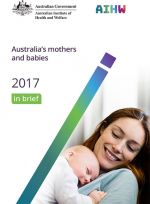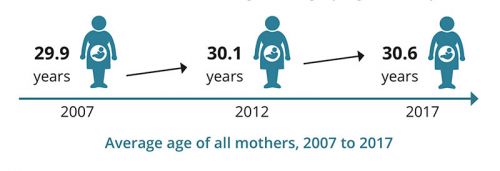Template:Main Page News: Difference between revisions
From Embryology
mNo edit summary |
mNo edit summary |
||
| (44 intermediate revisions by the same user not shown) | |||
| Line 1: | Line 1: | ||
{| width= | {| width=800px| | ||
|-bgcolor="CEDFF2" | |-bgcolor="CEDFF2" | ||
| <span style="font-size:150%">'''News - | | <span style="font-size:150%">'''News - Australia's mothers and babies 2017'''</span> | ||
|-bgcolor="F5FAFF" | |-bgcolor="F5FAFF" | ||
| valign=top| | | valign=top| [[File:Australia's mothers and babies 2017.jpg|thumb|150px|alt=Australia's mothers and babies 2017|link=Australia’s mothers and babies 2017]] | ||
[[File: | [https://www.aihw.gov.au/reports/mothers-babies/australias-mothers-and-babies-2017-in-brief/contents/table-of-contents Australia's mothers and babies 2017—in brief] (27 June 2019) | ||
* In 2017, 301,095 women gave birth in [[Australian Statistics|Australia]], an increase of 4.0% since 2007. | |||
* 30.6 was the average {{maternal age}} of all women who gave birth, compared with 29.9 in 2007. | |||
* 13% of women who gave birth in 2017 had {{gestational diabetes}} | |||
* 1 in 3 mothers had a {{caesarean}} section in 2017 | |||
* 6.7% of liveborn babies were low {{birthweight}} in 2017 | |||
: | [[File:Australian-maternal-age-2007-17.jpg|500px|link=Australia’s mothers and babies 2017]] | ||
{{Ref-AMB2017}} | |||
<br> | <br> | ||
{| class="wikitable mw-collapsible mw-collapsed" | |||
! Older News Articles | |||
|- | |||
| | | [[Template_talk:Main_Page_News|'''Older News Articles''']] - [[Template_talk:Main_Page_News#February|Rare Sesquizygotic Twinning]] | [[Template_talk:Main_Page_News#October|Spinal Muscular Atrophy Screening]] | [[Template_talk:Main_Page_News#February|Australian 2018 Pregnancy Care Guidelines]] | [[Template_talk:Main_Page_News#July|CRISPR]] | [[Template_talk:Main_Page_News#June|Ronan O’Rahilly]] | [[Template_talk:Main_Page_News#February|Gestational Diabetes]] | [[Template_talk:Main_Page_News#September|Kyoto eBook]] | [[Template_talk:Main_Page_News#August|Dolly's sisters live on!]] | [[Template_talk:Main_Page_News#June|Thalidomide in Zebrafish]] | [[Template_talk:Main_Page_News#March|Human pancreas stem cells]] | [[Template_talk:Main_Page_News#January|Oral contraceptive no risk of major birth defects]] | [[Template_talk:Main_Page_News#September|Maternal Malaria Neurovascular Development Effects]] | [[Template_talk:Main_Page_News#June|Oocyte/Spermatozoa fate decision]] [[Template_talk:Main_Page_News#April|Rubella eliminated in the Americas]] | [[Template_talk:Main_Page_News#February|Three-person embryos]] | ||
| | |||
|} | |} | ||
|} | |} | ||

